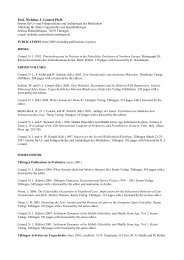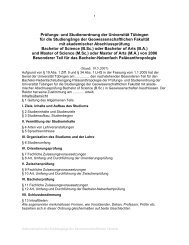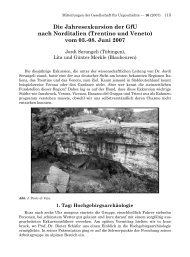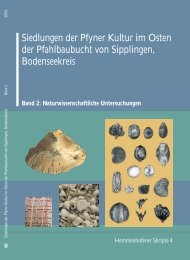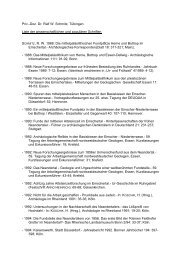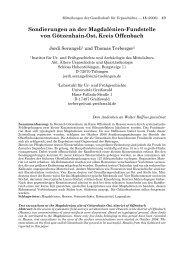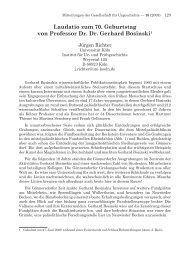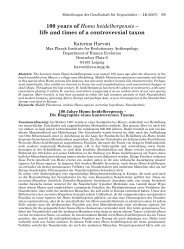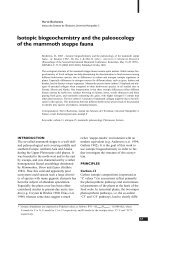bronze age environment and economy in the troad - Universität ...
bronze age environment and economy in the troad - Universität ...
bronze age environment and economy in the troad - Universität ...
Create successful ePaper yourself
Turn your PDF publications into a flip-book with our unique Google optimized e-Paper software.
chapter 2: methods<br />
The set of data of <strong>the</strong> identified <strong>and</strong> counted botanical rema<strong>in</strong>s<br />
raises <strong>the</strong> question of how far <strong>the</strong> data represent <strong>the</strong> orig<strong>in</strong>al<br />
situation. In o<strong>the</strong>r words, what are <strong>the</strong> processes affect<strong>in</strong>g <strong>the</strong><br />
assembl<strong>age</strong> between <strong>the</strong> beg<strong>in</strong>n<strong>in</strong>gs of <strong>the</strong> deposition of plant<br />
rema<strong>in</strong>s <strong>and</strong> recovery <strong>and</strong> analysis by <strong>the</strong> archaeobotanist The<br />
solution of <strong>the</strong>se questions is difficult, <strong>and</strong> even more so <strong>the</strong><br />
consideration <strong>and</strong> <strong>in</strong>tegration of <strong>the</strong> results <strong>in</strong>to <strong>the</strong><br />
<strong>in</strong>terpretation of <strong>the</strong> data. Some of <strong>the</strong> taphonomic effects on<br />
plant rema<strong>in</strong>s are known, e.g. that of combustion (more<br />
dam<strong>age</strong> occurs with <strong>in</strong>creas<strong>in</strong>g temperature). All later<br />
processes dur<strong>in</strong>g deposition, or sampl<strong>in</strong>g <strong>and</strong> extraction of <strong>the</strong><br />
carbonised rema<strong>in</strong>s, result ma<strong>in</strong>ly <strong>in</strong> fragmentation.<br />
For <strong>the</strong> taphonomic effects on macrorema<strong>in</strong>s dur<strong>in</strong>g<br />
carbonisation, Boardman <strong>and</strong> Jones (1990) obta<strong>in</strong>ed<br />
quantitative data from charr<strong>in</strong>g experiments. They tested<br />
destruction of different parts of <strong>the</strong> cereal plants caused by<br />
carbonisation. Their results suggest limits to <strong>the</strong> <strong>in</strong>terpretation<br />
of cereal rema<strong>in</strong>s. One of <strong>the</strong>ir ma<strong>in</strong> discoveries was that those<br />
components which are characteristic of early crop-process<strong>in</strong>g<br />
st<strong>age</strong>s <strong>and</strong> which are rarely represented <strong>in</strong> archaeological<br />
contexts (i.e. straw, free-thresh<strong>in</strong>g cereal rachis) are <strong>the</strong> first to<br />
be lost through charr<strong>in</strong>g. Crop-process<strong>in</strong>g might not to be<br />
recognised on this basis. Dur<strong>in</strong>g combustion, some of <strong>the</strong><br />
species/taxa seemed to be more resistant to destruction than<br />
o<strong>the</strong>rs. The gra<strong>in</strong> generally survives better than <strong>the</strong> chaff.<br />
E<strong>in</strong>korn chaff generally survives best. As already mentioned,<br />
glume wheat chaff survived better than rachises of naked wheat<br />
or barley, of which <strong>the</strong> latter was less resistant.<br />
Where little chaff from free-thresh<strong>in</strong>g cereals (rachis segments)<br />
is found at archaeological sites, this could be a result of loss of<br />
material by its pre-depositional combustion <strong>and</strong> might not<br />
necessarily reflect <strong>the</strong> orig<strong>in</strong>al function or even economic<br />
behaviour.<br />
Accord<strong>in</strong>g to Hillman (1983), electron sp<strong>in</strong> resonance (ESR)<br />
determ<strong>in</strong>ations of <strong>the</strong> charr<strong>in</strong>g temperature should be st<strong>and</strong>ard<br />
archaeobotanical procedure. This would show <strong>the</strong> likelihood of<br />
chaff <strong>and</strong> straw loss. The <strong>in</strong>terpretation of ESR results rema<strong>in</strong>s<br />
difficult, however, because of <strong>the</strong> somewhat unclear <strong>in</strong>fluence<br />
of depositional <strong>and</strong> post-depositional processes.<br />
With <strong>the</strong> material from Troy <strong>and</strong> Kumtepe, it has not been<br />
possible to <strong>in</strong>vestigate pre-depositional taphonomy by<br />
techniques such as ESR analysis. Therefore taphonomic<br />
consideration has had to concentrate on depositional <strong>and</strong> postdepositional<br />
processes. The follow<strong>in</strong>g section discusses some<br />
questions of taphonomy relat<strong>in</strong>g to <strong>the</strong>se processes. For this,<br />
sedimentological aspects were considered with<strong>in</strong> <strong>the</strong><br />
excavation. The need for a sedimentological analysis was<br />
suggested when a relationship between <strong>the</strong> amount of<br />
macrorema<strong>in</strong>s <strong>in</strong> <strong>the</strong> sediment <strong>and</strong> <strong>the</strong> sediment characteristics<br />
was observed dur<strong>in</strong>g <strong>the</strong> flotation process.<br />
At <strong>the</strong> beg<strong>in</strong>n<strong>in</strong>g of <strong>the</strong> flotation <strong>in</strong> 1993, it was observed<br />
tha<strong>the</strong> state of preservation of <strong>the</strong> rema<strong>in</strong>s seems to be related<br />
to <strong>the</strong> type of sediment <strong>in</strong> which <strong>the</strong>y are found. The first<br />
thought was that by underst<strong>and</strong><strong>in</strong>g this relationship, one would<br />
learn more about <strong>the</strong> depositional conditions of <strong>the</strong> sediment,<br />
<strong>and</strong> <strong>the</strong>refore of <strong>the</strong> rema<strong>in</strong>s, aid<strong>in</strong>g <strong>in</strong>terpretation not at least<br />
<strong>in</strong> terms of representativeness (Willerd<strong>in</strong>g 1971). In <strong>the</strong> first<br />
st<strong>age</strong> of this work a comprehensive analysis of <strong>the</strong> sediments<br />
was planned, but this aim was given up, because <strong>the</strong> laboratory<br />
efforts required were disproportionate to <strong>the</strong> value of <strong>the</strong><br />
results.<br />
Amongst <strong>the</strong> most promis<strong>in</strong>g qualities of <strong>the</strong> sediment that<br />
might be related to <strong>the</strong> taphonomy of carbonised rema<strong>in</strong>s are<br />
those that <strong>in</strong>dicate any k<strong>in</strong>d of mechanical process, for<br />
example, whe<strong>the</strong>r <strong>the</strong> quantity of carbonised rema<strong>in</strong>s is low<br />
when <strong>the</strong> sediment is chalky <strong>and</strong> rich <strong>in</strong> sharp-edged stones.<br />
Loss by ignition, which provides <strong>in</strong>formation on <strong>the</strong> organic<br />
proportion with<strong>in</strong> <strong>the</strong> sediment (e.g. microfauna, roots) was<br />
also thought to be suitable evidence for ‛mechanical stress’.<br />
Organic matter could represent <strong>the</strong> rema<strong>in</strong>s of aggressive<br />
<strong>age</strong>nts such as roots or microfauna, actively disturb<strong>in</strong>g <strong>the</strong><br />
sediment particles <strong>and</strong> <strong>the</strong>refore mechanically destructive of<br />
carbonised plant rema<strong>in</strong>s. The organic content <strong>in</strong> <strong>the</strong> sediment<br />
can be measured through <strong>the</strong> loss by ignition, <strong>the</strong> loss of weight<br />
after heat<strong>in</strong>g to 400°C represent<strong>in</strong>g <strong>the</strong> organic portion.<br />
The proportion of chalk (CaCO 3 ) was measured because of its<br />
potential to harden <strong>the</strong> sediment <strong>and</strong> to dam<strong>age</strong> <strong>the</strong> fragile<br />
carbonised rema<strong>in</strong>s. The content of chalk was measured with a<br />
second combustion at a higher temperature. The loss of weight,<br />
i.e. <strong>the</strong> former content of CaCO 3 can be calculated from <strong>the</strong><br />
molecular weight of <strong>the</strong> escap<strong>in</strong>g carbon dioxide. In general <strong>the</strong><br />
chalk proportion at Troy was slightly higher than that of <strong>the</strong><br />
Kumtepe samples. From <strong>the</strong> few samples analysed from Troy,<br />
those from <strong>the</strong> Lower City came up with <strong>the</strong> highest proportion<br />
of chalk (trenches I 17, p28 <strong>and</strong> w 28), due to <strong>the</strong>ir proximity<br />
to outcrops of bedrock. Samples from those trenches were at<br />
<strong>the</strong> same time quite poor <strong>in</strong> rema<strong>in</strong>s, so that one could assume<br />
a relationship exists. More samples have to be analysed,<br />
however, to prove that this pattern is not co<strong>in</strong>cidental.<br />
Fur<strong>the</strong>r, <strong>the</strong> results from <strong>the</strong> sediment analysis were planned to<br />
be related to fragmentation <strong>and</strong> distortion of <strong>the</strong> carbonised<br />
material. Preservation of <strong>the</strong> gra<strong>in</strong>s <strong>in</strong> <strong>the</strong>se samples was<br />
<strong>the</strong>refore recorded.<br />
Different methods exist for record<strong>in</strong>g <strong>the</strong> state of preservation<br />
of subfossil seeds <strong>and</strong> fruits, e.g. Murphy <strong>and</strong> Wiltshire (1994)<br />
for waterlogged material <strong>and</strong> Hubbard <strong>and</strong> al Azm (1990) for<br />
carbonised cereal gra<strong>in</strong>s. A scheme similar to that of Hubbard<br />
<strong>and</strong> Al Azm was used to evaluate <strong>the</strong> rema<strong>in</strong>s from Troy <strong>and</strong><br />
Kumtepe. This assessment scheme conta<strong>in</strong>s three states of<br />
fragmentation <strong>and</strong> three states of distortion that are estimated<br />
with scores from one to three for <strong>the</strong> carbonised cereal gra<strong>in</strong>s.<br />
The three states of fragmentation are ma<strong>in</strong>ly matter of postdepositional<br />
preservation. These are (1) ‛not fragmented’, (2)<br />
‛s<strong>in</strong>gle split offs, but with more than 50% of <strong>the</strong> gra<strong>in</strong><br />
preserved’, <strong>and</strong> (3) ‛heavily fragmented, difficult to identify’.<br />
Pre-depositional fragmentation, e.g. dur<strong>in</strong>g crop-process<strong>in</strong>g, is<br />
recognisable by swell<strong>in</strong>g at <strong>the</strong> surface of <strong>the</strong> break dur<strong>in</strong>g<br />
charr<strong>in</strong>g. Such gra<strong>in</strong>s were not considered. For corrosion or<br />
distortion, which ma<strong>in</strong>ly represents <strong>the</strong> effects of combustion,<br />
<strong>the</strong>re was <strong>the</strong> choice between an (1) ‛<strong>in</strong>tact surface’, (2) ‛s<strong>in</strong>gle<br />
split offs of <strong>the</strong> surface’ <strong>and</strong> (3) ‛surface hardly preserved, up<br />
to skeletal structure of <strong>the</strong> gra<strong>in</strong>’.<br />
The 30 samples which were evaluated for loss of ignition,<br />
chalk content, fragmentation <strong>and</strong> corrosion of <strong>the</strong> cereal were<br />
from different periods, <strong>and</strong> came from <strong>the</strong> Upper <strong>and</strong> <strong>the</strong><br />
Lower City of Troy <strong>and</strong> Kumtepe.<br />
19





